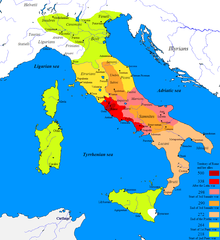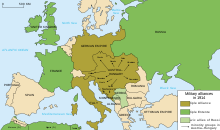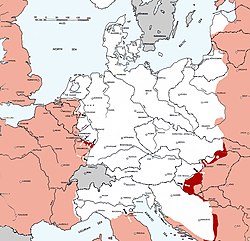Two-front war
According to military terminology, a two-front war occurs when opposing forces encounter on two geographically separate fronts. The forces of two or more allied parties usually simultaneously engage an opponent in order to increase their chances of success. The opponent consequently encounters severe logistic difficulties, as they are forced to divide and disperse their troops, defend an extended front line, and is at least partly cut off from their access to trade and exterior resources. However, by virtue of the central position, they might possess the advantages[1] of the interior lines.[2][3]
The term has widely been used in a metaphorical sense, for example to illustrate the dilemma of military commanders in the field, who struggle to carry out illusory strategic ideas of civilian bureaucrats, or when moderate legal motions or positions are concurrently opposed by the political Left and Right.[4][5] Disapproval and opposition by the domestic anti-war movement and civil rights groups as opposed to the bloody military struggle of the late Vietnam War has also been described as a two-front war for the US troops, who fought in Vietnam.[6][7]
Wars in antiquity

During the 5th-century BCE First Peloponnesian War the Greek polis of Athens had been embroiled in a drawn out struggle with the poleis of Aegina and Corinth among others and its primary enemy Sparta. Aware of the dangers of a battle with the superior Spartans, Athens concentrated on the conquest of Boeotia and thus avoid a prolonged two-front war.[8]
On several occasions during the third century BCE, the
Seven Years' War

The French and Indian War was a local conflict in North America, that occurred in the context of the trans-continental Seven Years' War. In 1755 armed forces of Great Britain under the command of General Edward Braddock invaded the territories of New France (eastern part of modern Canada, Mississippi and Ohio River Valleys and much of the upper Midwest of the modern United States) and attacked Fort Duquesne. Although numerically superior to the local French militia and their Indian allies, the British army became ensnared in a two-front conflict and was routed.[14][15]
Prussia had to fight against France, Austria, and Russia during the Third Silesian War, and also against Sweden during the Pomeranian War.
Napoleonic Wars
During the
World War I
Germany

During World War I, Germany fought a two-front war against France, Great Britain, Italy, Belgium and later also American forces on the Western Front and Russia and later Romania on the Eastern Front. Russian participation in the war ended with the 1917 Bolshevik October Coup and the peace treaty with Germany and Austria-Hungary was signed in March 1918.
Its central location in Europe and (currently) borders with nine neighboring nations fundamentally define Germany's politics and strategy. Bismarck successfully integrated Germany in his elaborate system of alliance of the European powers from 1871 until he was dismissed in 1890 by the new Emperor Wilhelm II.[19] Wilhelm embarked on an imperialist great power political course, neglected the alliances and his irrational expansion of the Imperial Navy triggered an arms race and seriously damaged the relations with France and Great Britain. By 1907, France had established an alliance with Great Britain and Russia. The German Empire found itself encircled and isolated.[20][21][22][23]
German military strategists had to adapt to the new strategic situation and developed the Schlieffen Plan. A series of military operations, that were to counteract being surrounded and, if exacted ruthlessly, will lead to victory.[24] Under the Schlieffen Plan, German forces would invade France via Belgium, Luxembourg, and the Netherlands (the idea to go through the Netherlands was abandoned because of its neutrality), quickly capturing Paris and forcing France to sue for peace. The Germans would then turn their attention to the East before the Russian army could mobilize its massive forces. The Germans failed to achieve the plan's objectives.[25][26][27]
Austria
In 1866 the Austro-Hungarian Army was left with no other option but to divide its armed forces and disperse them on two fronts during the Austro-Prussian War against Prussia to the North and the Kingdom of Italy to the South in the Third Italian War of Independence. The Prusso-Italian alliance was agreed upon an initiative of the Prussian Minister President Otto von Bismarck.[28]
In 1914 Austria-Hungary commenced the First World War by attacking Serbia at the Balkan front. After just a few weeks Austria-Hungarian troops clashed with the numerically far superior Russian imperial army in the Battle of Galicia at the Eastern front.[29] When Italy joined the conflict in May 1915 on the Allied side and deployed in strength at the Alpine front to the south, Austria-Hungary was already critically undermanned and faced serious recruitment shortfalls, which diminished the chances to exact an early defeat on any of the opponents, instead be confined to struggle in a two-front war at the periphery of its own territory. Consequently, the Austro-Hungarian Army lacked the initiative and the contributions at the Macedonian front (Salonikifront) were marginal. Nonetheless, when Romania entered the war on the Allied side in August 1916 at the southern tip of the Eastern front, Austria-Hungary acted promptly and concluded this stage in late 1916 and occupied large areas of Romania. The greater two-front war only ended after the separate peace with Russia in March 1918, which, after all, did not forestall the collapse of the imperial army in the course of summer and autumn.[30]
World War II
A two-front war scenario, almost identical to the first World War would eventually aggregate in the
Adolf Hitler initially attempted to avoid a two-front war as he engaged and crushed his opponents successively. In 1940, however, he failed to beat Great Britain in the air battle and in 1941 attacked the Soviet Union. Great Britain in relative safety on its island remained unbeaten and managed to maintain the western front. Hitler also failed to neutralize Great Britain and avoid a two-front war.
Germany, that lacked the resources for a long war, failed to achieve a quick victory in the east and eventually collapsed under the pressure of a
The
The
Poland fought a two front war with Germany and Russia during WWII.
Cold War
A major rationale for the American 600-ship Navy plan in the 1980s was to threaten the Soviet Union with a two-front war, in Europe and the Pacific Ocean, in the event of hostilities.[41]
Arab–Israeli wars
In the 1948 Arab–Israeli War, the Israelis fought the Egyptians to the south and the Jordanians and Syrians in the east and the north. Israel again fought two-front wars in the Six-Day War of 1967 and the Yom Kippur War of 1973.[42][43][44]
Conflicts of the 21st century
India, Pakistan and China
India's relations with Pakistan and China have for many decades been uneasy and, in fact, greatly disturbed by unsettled border feuds. The discord with Pakistan is by far the more complicated one, because both parties claim exclusive sovereignty over an entire historic region, the state of Jammu and Kashmir.[45] Although matters were settled and signed in 1972, armed forces face each other, entrenched on both sides of the volatile border, the Line of Control. Attempts to directly or indirectly wrest territory from each other has hardly been successful and always caused fierce reactions.[46][47]
India and China have, despite more than a dozen rounds of border talks and the uneasy Line of Actual Control, as yet failed to negotiate a conclusive agreement. For decades, the Indian press and media have pointed at political tensions and deteriorating relations with China, caused, among other things, by occasional Chinese military incursions into Indian-controlled territory.[citation needed]
In 2013 the
The Government of India has professed security concerns and repeatedly expressed its disapproval of the CPEC project, as a number of the projects come about on territory claimed by India.[48][49]
According to an Indian army general in 2018, war on multiple fronts was "very much in the realm of reality", as the consequence of ideas of isolation and concerns about the clandestine strategic commitment of China and Pakistan, as the Congress in Beijing has provided assistance to Pakistan's nuclear weapon and missile programmes.[50]
References
- ISBN 978-0-19-162251-9.
- ISBN 978-0-313-32383-6.
- ^ "Interior Lines". Encyclopedia Com. Retrieved May 1, 2020.
- ISBN 978-0-8061-8610-8.
- ^ Uri Friedman (March 3, 2017). "America's Two-Front War of Ideas". The Atlantic Monthly Group. Retrieved May 19, 2019.
- ISBN 978-0-8262-7259-1.
- ISBN 978-1-55587-975-4.
- ISBN 978-1-58836-490-6.
- ISBN 978-0-521-06185-8.
- ISBN 978-1-84415-635-1.
- ^ Michael Auslin (September 9, 2014). "Don't Do As the Romans Did…". POLITICO LLC. Retrieved May 1, 2020.
- ISBN 978-0-19-515954-7.
- ^ "Transoxiana 04: Sasanians in Africa". Transoxiana.com.ar. Retrieved May 1, 2020.
- ISBN 0375406425.
- ^ "The Battle of the Monongahela". WDL. Retrieved May 1, 2020.
- ISBN 978-1-139-44356-2.
- ISBN 978-1-4728-1009-0.
- ^ Jeremy Black (January 2012). "Wellington's Two-Front War: The Peninsular Campaigns, at Home and Abroad, 1808-1814". Historian. Academia. Retrieved May 13, 2020.
- ^ John A Smoot. "The Bismarck Plan: German Unification and the Balance of Power". Academia. Retrieved May 13, 2020.
- ISBN 978-3-17-012097-6.
- ^ On the Kaiser's "histrionic personality disorder", see Tipton (2003), pp. 243–245
- S2CID 163767674.
- ^ Herwig, Holger (1980). Luxury Fleet: The Imperial German Navy 1888–1918.
- ISBN 978-0-8131-4747-5.)
{{cite book}}: CS1 maint: multiple names: authors list (link - ^ Michael Peck (November 11, 2018). "Germany Could Have Won World War I. Here's How". Center for the National Interest. Retrieved May 19, 2019.
- ISBN 978-0-14-193886-8.
- ISBN 978-0-19-164771-0.
- ISBN 978-0-521-62951-5.
- ISBN 978-0-521-81735-6.
- ^ "Crisis mounts in Austria-Hungary amid hunger and discontent". HISTORY com. November 16, 2009. Retrieved May 2, 2020.
- ISBN 978-0-7864-5667-3.
- ISBN 978-1-60223-135-1.
- ^ Jeffrey Billman. "The Effects of the Two-Front War on Germany During WWII". Leaf Group Ltd. Retrieved May 19, 2019.
- ^ Higgins Trumbull (April 1, 1967). "Hitler And Russia: The Third Reich in a Two-Front War, 1937–1943". Oxford University Press. Retrieved May 19, 2019.
- ISBN 978-1-317-86504-9.
- ^ Leo J. Meyer. "The Decision To Invade North Africa (TORCH)". U.S. Army Center of Military History. Retrieved May 1, 2020.
- ISBN 978-1-4027-4090-9.
- ISBN 978-1-78289-397-4.
- ISBN 978-1-60819-409-4.
- ISBN 978-0-253-11109-8.
- ^ "Ship Building 1981-89 - Reagan, Ronald". Global Security. Retrieved May 1, 2020.
- ISBN 978-1-62287-755-3.
- ISBN 978-0-307-42965-0.
- ISBN 978-1-137-07926-8.
- ^ "Jammu and Kashmir, union territory, India - History". Encyclopædia Britannica. Retrieved May 2, 2020.
- ^ "Kashmir Fast Facts". CNN. March 26, 2020. Retrieved May 2, 2020.
- ISBN 978-0-415-93922-5.
- ^ "PM Modi told China, Pakistan economic corridor unacceptable: Sushma Swaraj". No. 31 May 2015. Zee News. Retrieved May 2, 2020.
- ^ "China-Pakistan Economic Corridor 'unacceptable', Modi tells China". The Express Tribune. 1 June 2015. Retrieved May 2, 2020.
- ^ Rajat Pandit (July 13, 2018). "Two-front war is a real scenario, says General Bipin Rawat". The Economic Times India. Retrieved May 2, 2020.

